Centauri Dreams
Imagining and Planning Interstellar Exploration
The Path to Beamed Sails
Several years ago in Italy Les Johnson told me that he had once had the coolest job description in NASA. And I remember those days in the early 2000s when I was just beginning to investigate interstellar issues, and Les, working at Marshall Space Flight Center in Huntsville, carried a NASA business card describing him as ‘Manager of Interstellar Propulsion Technology Research.’ These days Les’ title is not quite as exotic but he’s involved as ever with solar sails.
Les is also an author, and among his many books is one I recommend to anyone trying to learn more about solar sails. Written with Gregory Matloff and Giovanni Vulpetti, Solar Sails: A Novel Approach to Interplanetary Travel (Copernicus, 2008) reviews the history of the concept going back to James Clerk Maxwell, who pointed out in his monumental work on electric and magnetic fields that photons can impart force to an object they encounter. Konstantin Tsiolkovsky and the Latvian scientist Friderikh Arturovich Tsander went on in the early 20th Century to describe huge mirrors made of thin materials that used photons for propulsion.
Johnson pointed out to the audience at Starship Congress in Dallas that the effect of photons on spacecraft was readily apparent as early as 1960, when NASA launched ECHO 1, a communications satellite that was essentially a giant metal balloon off which signals could be bounced. A large reflective object like this responds to the momentum being exerted upon it by photons, an effect that could now be observed in space. But a lot of people aren’t aware of what Les went on to describe, the use of photon-imparted momentum to save Mariner 10.
Launched in 1973, the craft used a gravity assist around Venus to put it on a trajectory to study Mercury, entering a solar orbit that would allow several close passes by the planet. Flaking paint from Mariner 10’s high-gain antenna confused its navigation sensors, ultimately causing the spacecraft to roll, activating its gyroscopes and venting critical attitude control gas into space. The guidance and control team at JPL was able to solve the problem by tilting Mariner’s solar panels, allowing photon pressure to create enough torque to counter the aberrant motion.

Image: Les Johnson in a NASA photo. My inexpert camera work didn’t produce a good image during Les’ talk in Dallas, so I rely on Google’s image database.
Sunjammer and Its Contemporaries
The point could not be clearer: We know a lot about the physics here, and with solar sails, even though we have only two thus far successfully launched, we’re dealing with principles that have been understood for a long time. There was serious talk about a solar sail mission to Halley’s Comet in the 1980s, with a team at JPL developing several sail designs, among them a heliogyro with multiple blades and a sail that reached 640,000 square meters, a half mile to the side. The comet mission would have jump-started the sail business but NASA rejected the proposal as too risky. Lou Friedman, former director of the Planetary Society, has written about all this in another book you’ll want on your shelf. It’s Starsailing: Solar Sails and Interstellar Travel (John Wiley & Sons, 1988), a bit hard to find these days but well worth the effort.
I had heard about the Japanese IKAROS sail before it launched in 2010 but the reality of it didn’t really sink in until I watched the actual launch. I had a window up on my computer when my wife walked by and asked what I was looking at. “The Japanese are launching a solar sail,” I said, preoccupied as the countdown continued. She walked on out of the room and then came right back. “They’re launching what?!” She knew all about solar sails (the consequence of living with me), but she was startled that after all the NASA work, along with serious studies by DLR in Germany and the Russian Progress mirrors, it was Japan that actually took a sail into space.
Johnson told me after his talk that IKAROS had truly galvanized the sail community. NanoSail-D, launched late in 2010, came next, a three-unit CubeSat that had been built as a spare for an original sail that was lost in a 2008 launch attempt. I still remember Greg Matloff calling me up after the first launch failure to tell me there was a second NanoSail, and I told him he reminded me of S. R. Hadden, the billionaire in the film Contact who tells Ellie Arroway that there is a second stargate machine after the first one is destroyed. “Why build one when you can build two for twice the price?” says Hadden, memorably played by John Hurt.
The second NanoSail-D did the trick, deploying a 10 square meter sail after a rather dramatic delay. The sail spent 240 days in orbit before re-entering the atmosphere. Now, of course, we have Sunjammer to look forward to, a major step up from NanoSail-D. NASA is saying that Sunjammer will produce a maximum thrust of approximately 0.01 newton, the rough equivalent of the weight of one of those packets of artificial sweetener you see on cafe tables. That level of thrust makes the point that sails operate slowly but surely, with a constant acceleration that, over time, achieves velocities fully compatible with exploring the inner Solar System.

Image: NASA engineers look at a 20-meter solar sail and boom system, developed by L’Garde Inc. of Tustin, Calif., after it is fully deployed during testing at NASA Glenn Research Center’s Plum Brook facility in Sandusky, Ohio. Red and blue lights help illuminate the four triangular sail quadrants as they lie outstretched in Plum Brook’s Space Power Facility — the world’s largest space environment simulation chamber. The sail material is supported by a series of inflatable booms that become rigid in the space environment. Credit: NASA/MSFC.
A Clear Roadmap for Sails
For interstellar purposes, of course, we want to do more than move supplies around the Solar System, and that is why Robert Forward started thinking in the early 1960s about pushing a huge solar sail with lasers. We might call this a ‘beamed sail’ or perhaps a ‘lightsail,’ though I like ‘beamed sail’ better because microwaves may be an even better way to push a sail and ‘lightsail’ implies lasers. In any case, the beaming idea is what counts, and Forward was soon joined by George Marx in exploring the idea. Marx wrote up a laser-driven sail concept in Nature in 1966, and we’ve been taking it apart and putting it back together ever since.
The path of sail development, though, is clear, as Johnson explained to the Starship Congress audience. You get to beamed sailcraft by first developing expertise with conventional solar sails. When the Planetary Society was attempting to launch its Cosmos sail in 2005, the plan had been to deploy and test the first operational sail, and as a part of that process a beamed microwave experiment was planned using the Deep Space Network’s Goldstone facilities. We would have learned much about the forces on the sail and how to maneuver it using both solar photons and microwaves if the craft had not been destroyed in a failed launch attempt.
We must hope Sunjammer has a better fate in its 2014 launch. Johnson said the design uses inflatable booms that are malleable and thus deployable, after which they become rigidized by the cold. The plan is to demonstrate attitude control and test the stability of the craft while performing maneuvers and moving close to the L1 Lagrange point to make scientific observations for NOAA (National Oceanic and Atmospheric Administration), which is one of the sponsors of the flight. There’s already a NOAA satellite at L1 that allows a ten to fifteen minute warning of solar storms. The beautiful thing about a sail is that it can move closer to the Sun than L1 and essentially ‘hover’ there, doubling the warning time for potential flare-induced power outages.
Of course, there are many things you can do with a solar sail, and Johnson’s comments ran the gamut. A geosynchronous satellite circling the Earth above the equator is able to stay over the same location on Earth, but you can’t accomplish that trick if you want to hover over the poles for scientific studies. Not unless you use a sail in a ‘polesitter’ orbit that relies on photon pressure to maintain its position. Robert Forward took out a patent on this concept, which he called a ‘statite,’ meaning a spacecraft that, although not orbiting, essentially hovers in place.
Forward wrote the concept up in a 1990 article for Analog and later in a story he called “Race to the Pole.” He describes how the sail would be positioned over the polar regions:
“.. . with the sail tilted so the light pressure from the sunlight reflecting off the lightsail is exactly equal and opposite to the gravity pull of the Earth. With the gravity pull nullified, the spacecraft will just hover over the polar region, while the Earth spins around underneath it.”
You can see what’s happening here: You’re balancing the Earth’s gravity and that of the Sun along with the centrifugal force of the Earth’s orbit around the Sun. A polesitter like this would be stable at about 250 Earth radii, a lot farther out than most communications satellites (about 6 Earth radii), but while this would be problematic for voice communications, it would be no problem for broadcasts into polar regions, and would allow useful meteorological studies.

Image: Dallas as viewed from my hotel room after the first day of Starship Congress.
I’ve hardly exhausted the sail mission concepts that have been studied, so we’ll continue in the same vein tomorrow. From a longer-term perspective, though, I want to emphasize that sails are a technology that can pay off at every level of development. As we look at practical uses for these craft in the near future, we can also contemplate developing them as interplanetary vehicles, perhaps as carriers of supplies to bases on Mars or the asteroids. And we can begin testing how sails behave under beamed power, knowing that building this expertise may one day lead us to space-based beamers that can drive a sailcraft out of our Solar System on an interstellar trajectory.

Key Issues for Interstellar Sails
The evening after Jim Benford’s Starship Congress talk on his solar sail lab work at the Jet Propulsion Laboratory, a small group of sail advocates joined him in the Hilton Anatole’s top floor restaurant to talk over the issues. Benford is organizing Project Forward, named after the legendary Robert Forward, as an Icarus Interstellar effort to further refine the interstellar beamed sail concept. Asked to name the biggest problem areas for sails, the group came up with several, but at the top of the list was deceleration. How do you slow a beamed sail down when it arrives at its target?
A number of possibilities suggest themselves and at this point all of them are completely theoretical. Forward himself wrote up a ‘staged sail’ concept, in which the outer ring of the sail detaches as the star is approached, moving ahead of the inner ring and attached payload. The Earth-based beamer bounces the laser off the larger sail ring, which reflects it back to the smaller sail and slows it for orbital insertion. The maneuver is described in Forward’s 1984 novel Rocheworld, where a three-part sail is used to allow for crew return.
Here’s Forward’s description of a mission to Barnard’s Star on the sailship Prometheus as the sail staging has begun. The inner sail (and payload module) is being turned around so as to receive laser light from the outer ring segment, called the ring-sail:
As the central sail was almost halfway around, the ring-sail readjusted again and started to bring the rotation of the central sail and Prometheus to a halt. The teamwork of the four computers was perfect. The rotation stopped at the same instant the central sail was exactly one hundred and eighty degrees around. The central sail now had its back to the light coming from the solar system while it faced the focused energy coming from the ring-sail. Since the ring-sail had ten tines the surface area of the central sail, there was ten times as much light pressure coming from the ring-sail than from the solar system. The acceleration on the humans built up again, stronger than before, but now it was a deceleration that would ultimately bring them to a stop at Barnard.
Have a look at the diagram below to see the basic method. If the image looks familiar, it’s because this is one of the few I’ve found illustrating Forward’s idea, taken from his original paper on a mission to Epsilon Eridani. Remember that Forward was assuming a huge lens in the outer Solar System which would be used to keep the beam tightly collimated. You can see how complicated this is, and why a magsail also suggests itself as a somewhat more direct option, though braking against a star’s stellar wind brings up numerous problems of its own.
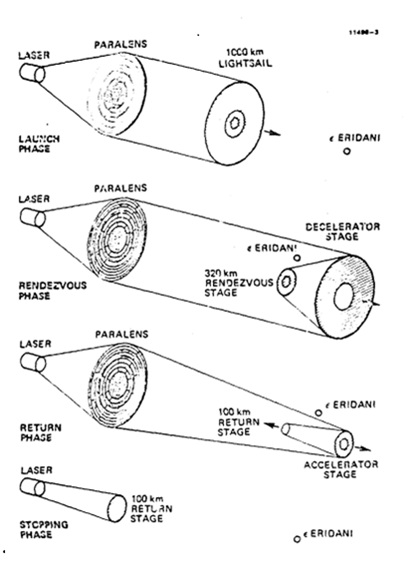
Image: Forward’s separable sail concept used for deceleration, from his paper “Roundtrip Interstellar Travel Using Laser-Pushed Lightsails,” Journal of Spacecraft and Rockets 21 (1984), pp. 187-195. The ‘paralens’ in the image is a huge Fresnel lens made of concentric rings of lightweight, transparent material, with free space between the rings and spars to hold the vast structure together, all of this located between the orbits of Saturn and Uranus.
If you look at the Forward scheme, though, you can see why the second big problem for beamed sails is jitter. No matter how accurate your beamer, you’ve got huge issues trying to deliver a laser beam to a sail ten light years away, a kind of accuracy that’s just as breathtaking as the power requirements for driving the sail in the first place — Forward’s Epsilon Eridani mission calculation cited a power requirement of 7.2 terawatts. In fact, in a 2003 paper, Travis Taylor and Gregory Matloff took note of the jitter issue and how far we are away from solving it:
The analysis given here, which did not take into account pointing jitter, suggests a minimum of about 15 km in radius for the collector. If pointing error is considered, it appears that the current state-of-the-art of jitter control is many orders of magnitude from enabling a laser sailing mission. Beam control is the largest obstacle for laser sailing.
Building Large Structures in Space
But it’s interesting to see that useful work is being done on the matter of building and deploying large structures in space. Forward’s company Tethers Unlimited, which he founded in 1994 in partnership with Robert Hoyt, has just been awarded a $100,000 grant to develop its SpiderFab project, which will use 3D printing methods in orbit to create the kind of structures we need. You can see how critical this is: Right now a major part of the cost of engineering and launching space systems revolves around the demands of surviving the launch phase, not to mention the cost of the launch itself. Tethers Unlimited plans to find ways around the problem, as described in a report Hoyt wrote for NASA:
We propose to develop a process for automated on-orbit construction of very large structures and multifunctional components. The foundation of this process is a novel additive manufacturing technique called ‘SpiderFab’, which combines the techniques of fused deposition modeling (FDM) with methods derived from automated composite layup to enable rapid construction of very large, very high-strength-per-mass, lattice-like structures combining both compressive and tensile elements. This technique can integrate both high-strength structural materials and conducting materials to enable construction of multifunctional space system components such as antennas.

Image: SpiderFab combines techniques evolved from terrestrial additive manufacturing and composite layup with robotic assembly to enable on-orbit construction of large spacecraft components optimized for the zero-g environment. Credit: Tethers Unlimited/NASA.
Rob Adams (NASA MSFC) described current work on 3D printing in his session at Starship Congress, a technique that would make it possible to create parts on the fly, and one that could even be used for printing out various kinds of foods — NASA has been looking at 3D treatments of pizza (I kid you not) as an experiment in lowering food waste and varying what astronauts eat to go beyond the typical pre-packaged fare. SpiderFab is a step further, the kind of robotic technique that could one day be used not only to build kilometer-scale sails but also key parts of the beamer.
We’re in the early days of sail design but we’re making progress, both in the lab and in space through missions like IKAROS and NanoSail-D. I think too about the two sails that NASA deployed at its Plum Brook facility in Sandusky, Ohio in 2005. These were demonstrators built within a vacuum chamber that have paved the way for Sunjammer, a mission Les Johnson described to the Starship Congress audience. Sunjammer folds up into something the size of a dishwasher, but when deployed in space it will have spread to 1200 square meters, seven times the area of the IKAROS sail, while weighing a scant 32 kilograms (ten times less than IKAROS).
Launch of Sunjammer is currently planned for next year. The mission stirs fond memories of Arthur C. Clarke, whose story “Sunjammer” inspired its name. We should also acknowledge Poul Anderson, who confusingly enough published a story of the same name in Analog a month after Clarke’s story appeared in a 1964 issue of Boy’s Life. You’ll find the Clarke story retitled “The Wind from the Sun” in many anthologies, but whatever its name, the story of a solar sail race to the Moon firmly established the sail concept as a player in the minds of science fiction readers and helped its acceptance by the public.
Johnson, whose recent book Going Interstellar (co-edited with Jack McDevitt) should be on the shelf of any interstellar advocate, went on to describe the Sunjammer mission and a number of other sail concepts currently under development. I had intended to get to all of these today but in my enthusiasm I’ve run out of time, so we’ll continue with more of Les Johnson and talk of where sails are going tomorrow. I was glad to see that Starship Congress was heavy on sail technologies, including the uses of nanotechnology and an interesting idea for a beamed laser infrastructure that we’ll be examining as I continue sorting out my notes.
The Taylor and Matloff paper referred to above is “Space Based Energy Beaming Requirements for Interstellar Laser Sailing,” CP664, Beamed Energy Propulsion: First International Symposium on Beamed Energy Propulsion, ed. By A.V. Pakhomov (2003), American Institute of Physics 0-7354-0126-8.

The Sail Comes to Texas
Low clouds had descended upon Dallas when I landed at Love Field, and by the time I got to the Hilton Anatole for the Starship Congress being hosted by Icarus Interstellar, the city outside was swathed in mist. This was last Wednesday evening, and it was late enough by the time I had dinner that a quick stroll through the cavernous facility was about all I wanted to do before getting some sleep. The Anatole, though, was gorgeous, filled with paintings and sculpture, some of which (two statues of elephants) became helpful landmarks as I learned to navigate the place.

Image: An atrium at the Hotel Anatole at night, one of two, connected so that inveterate walkers like myself could make figure-eight circuits by following the room corridors on any floor.
Starship Congress was a roaring success, the kind of thing that happens when you put people with passionate interests in the same place who usually know each other only through email or by reputation. Saving the day for me on day one was my friend Pat Galea, an Icarus Interstellar fixture, who had brought one of those little MiFi ‘hotspots’ with him. For we learned that the hotel wireless didn’t extend into the meeting room, but Pat, who is to computer issues what Itzhak Perlman is to violins, soon had four of us up and running with a slow but adequate connection. That allowed me to send out the occasional tweet and check various things on Google.

I was glad that the Icarus Interstellar Kickstarter campaign had gone as well as it had, raising a good deal more than the initial goal, and thus funding the travel costs of a number of speakers. We’re all learning our way with crowdsourcing tools like Kickstarter, but they offer a level of public engagement that Richard Obousy, Icarus Interstellar’s president, acknowledged in his opening remarks. In the post-Apollo era, everyone is aware of the need to find ways to engage the public in the great issues of space exploration, and having a stake in an interstellar conference, even if the contributor can’t make the trip, is one way to get this done.
Riding the Sail
My conviction is that the first serious mission targeting another star will use sail technologies in one form or another. The first conference session was devoted to sails, leading off with Jim Benford’s keynote, followed by Les Johnson, who described current and near-term work. Right now the only propulsion method that will get us to interstellar velocities is the sail, and even then we’re talking no more than a couple of hundred kilometers per second, so it’s still a long trip. The Alpha Centauri crossing at 300 kilometers per second (perhaps realizable through a close pass by the Sun with deployment of the sail at perihelion) would still take 4300 years.
This is always a bit of a mind-bender because Voyager 1, the fastest probe we have leaving the system right now, moves at a ‘mere’ 17 kilometers per second, and while New Horizons topped that briefly in the early part of its journey, it will ultimately pass Pluto/Charon at about 13.9 kilometers per second. We need to find ways to ramp these numbers up, and that search begins in the lab. What Benford described in the opening session was a series of experiments he and his brother Greg made on beamed propulsion back in the year 2000. The researchers were working with a carbon fiber mat shaped into a small sail with a thickness of less than 1 millimeter.
Carbon fiber is ideal for sail work because when you put a microwave beam on the sail the material absorbs energy and begins to heat. A sail made of aluminum would begin to melt as you reach about 900 K, limiting possible accelerations, but carbon fiber has a low areal density (about 8 grams per square meter in the material the Benfords used) and a microwave reflectivity approaching 90 percent. The material is actually a carbon-carbon microtruss, meaning a core of carbon fibers is fused to a textured outer surface. With carbon nanotubes woven into the material, this microtruss is capable of temperatures up to 3000 K, at which point it doesn’t melt but sublimes, going from solid to gas with no intervening liquid state.
Working with a sail in an Earth-bound laboratory means you have to achieve an acceleration of one g just to lift off, but the Benfords were able to get up to 10 gs in these experiments, using a wavelength of about 3 centimeters and a pulse duration of 0.2 seconds. Although the tiny experimental sails began to heat up at higher beam powers and bounced off the ceiling of the lab, they survived and remained undamaged after the flight.
All this is provocative because a normal solar sail — think Japan’s IKAROS, for example — is pushed solely by sunlight, the fact being that while photons have no mass they do impart momentum. That’s fine when working in the inner Solar System but the effect of sunlight drops drastically as you move outward, dropping off by the inverse square of the sail’s distance from the Sun. In other words, a sail at Jupiter’s 5 AU from the Sun receives only 4 percent of the sunlight it would in Earth orbit, so an outbound sail is going to need a microwave or laser push if we want to keep it under acceleration all the way to system’s edge and beyond.
Enter the Beam Riders
The laboratory work that has been done thus far is highly encouraging. Having learned that a sail can indeed be pushed to high accelerations by using a microwave beam, the Benfords were also able to show that a sail of the right shape — concave and something like a parachute — will be stable and stay centered in the beam. In fact, the beam induces a sideways restoring force so that even assuming a certain amount of ‘jitter’ in the beam itself, the sail is capable of riding the beam. We’re a long way from the laboratory to the gigantic sails envisioned by Robert Forward, but we’re getting good indications that once we have the expertise to build the right kind of ‘beamer’ in space, the physics will allow sail missions that can reach interstellar velocities.
Transmitting angular momentum to a sail through a beam of photons has also been demonstrated and is, in Benford’s words, ‘a trivial process,’ so that sail deployment might become a matter of putting a large sail into space and inducing a spin to unfold it. Whatever deployment method might be used, the fact that a beam can carry angular momentum means that controllers can stabilize the sail against yaw and drift once deployed. Keep in mind, too, that a number of sail mission concepts actually call for lower power densities than the Benfords needed in the lab — remember, they were pushing the sail from deep within a gravity well. So the experimental case for beamed sails is solid and we can look forward to space-based testing.
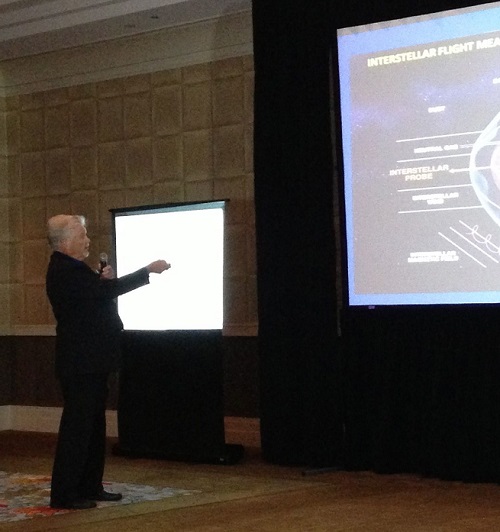
Image: Jim Benford discusses the experiments he and his brother performed on sail beaming at the Jet Propulsion Laboratory.
Half a million dollars produced the results Benford described, making the point that while we do have these initial results, we lack a large body of data to draw from not just with sails but most other interstellar propulsion proposals as well. “We have far too many concepts and far too little data,” Benford reminded the audience, adding that “Nature will produce the answers if we ask the correct questions.” Indeed. And these experiments tell us that useful work this early in the interstellar process can grow out of laboratory studies that aren’t hugely expensive. The interstellar community should be thinking about how it can support such ground-breaking work not only on sails but other proposed solutions to the interstellar propulsion conundrum.
One of the exciting thing about interstellar studies is the sheer number of questions it raises. With sails we are dealing with a subject that has moved out of the conceptual phase. We know the physics and are beginning to demonstrate sail methods here on Earth. We can now move in two directions, the first being to work on new materials that will be lighter and more responsive to the beam on the sail. The second step, an obvious one, is to continue with actual space deployments of sails and begin to do beaming experiments on them. More tomorrow as I look at other sail presentations from Starship Congress, beginning with Les Johnson’s overview on what we’ve accomplished so far in space and what we can expect in the next few years.

Starship Congress in Dallas
Starship Congress, toward which I am headed as you read this, begins on Thursday. In the nine years and counting that I’ve been writing Centauri Dreams, I’ve been happy to see how many conferences have taken to archiving or, even better, streaming their proceedings so that those who can’t attend can follow along. Live streaming from Starship Congress will be available here, according to Icarus Interstellar. And if you’re a Twitter person, the tag for the conference is to be #starshipcon, which should be an active place to watch. Further information here.
I’m posting this automatically because today is a travel day, and another conference brings up the inevitable question about how best to cover it. I’ve tried every method in the book but have learned that so-called ‘live blogging’ just doesn’t work, at least for me. I can crank out constant updates but I wind up with a muddled notion of the big picture and my notes aren’t as detailed as I would like. I tried to tweet my way through the last 100 Year Starship Symposium, but that was worse, leaving me with a series of snippets that were hard to reconstruct into a whole.
So I plan to do in Dallas what I did last February in Huntsville (at the Tennessee Valley Interstellar Workshop), namely, to put my time and attention into note-taking to get as accurate and thorough a picture of as many presentations as I can. I’ll then write these up during the week following the event, with notes spread before me and the perspective that an overview brings. If you follow me on Twitter, I’ll still be operating as @centauri_dreams, and if I can post a few photos here on the site I’ll do so, but most of my effort for the rest of the week will be note-taking.
It’s going to be a packed schedule, but I’ll also try to keep up with comment moderation on Centauri Dreams. Looking forward to seeing many of you in Dallas!
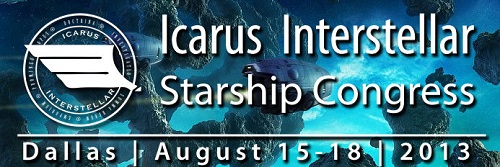
Earthbound Tests for Titan Lake Lander
As we saw last week, touching down on Europa is going to be a tricky maneuver, at least based on the surface mapping we have so far, where boulders show up all the way down to the limits of resolution. That’s why we need better imagery from the moon, a major motivation for the proposed Europa Clipper. Titan poses far fewer problems. Its thick atmosphere allowed the Huygens probe to land softly after a long, slow descent by parachute. Proposals for Titan missions have included boats to explore its lakes (Titan Mare Explorer) and airborne laboratories to soar through its skies (AVIATR: Aerial Vehicle for In-situ and Airborne Titan Reconnaissance).
The SETI Institute, working with NASA, has been testing the lake option at Laguna Negra, a lake in the Chilean Andes, in a project called Planetary Lake Lander (PLL). The idea is to develop the kind of autonomous hardware we’ll need to explore Titan from the surface. But PLL is a dual-purpose mission that also studies the watershed of Chile’s Echaurren Glacier, a freshwater source for millions that is rapidly disappearing. The expertise the researchers bring to the lake thus becomes useful not only in modeling a highly changeable environment on Titan but also in providing real-time data on the impact of deglaciation on terrestrial lake habitats and biology.
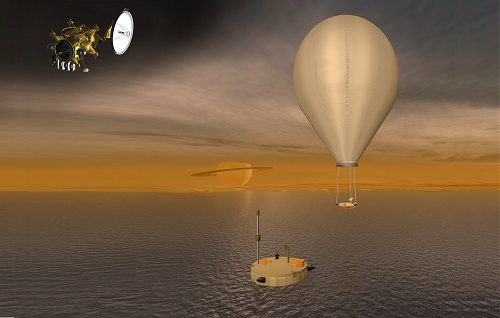
Image: The NASA Lake Lander robots lands on Titan’s lake in an artist’s imagining. Credit: NASA/JPL.
The prototype robot has been operational since 2011, charting the lake’s depth and making a variety of scientific measurements. A report from Laguna Negra by one of the team members last December describes testing the PLL on a three-kilometer sail across the lake in a journey that took eight hours, with data from the lander being sent to NASA Ames as it would be on a real mission, though via orbiting communications satellites rather than the Deep Space Network. A real mission would also cope with bandwidth restrictions not being mimicked in this work.
This National Geographic article notes that the current PLL unit is too heavy to ever make it into space, but astrobiologist Nathalie Cabrol, who leads the lander’s science team, likens the work to where the Mars rover teams were ten to fifteen years ago, when their prototypes were undergoing tests in the desert. PLL has been at Laguna Negra conducting unsupervised operations through the Chilean winter, but the researchers plan to return to work on the robot’s sensors and problem-solving capabilities, crucial in an environment where communications times run in hours in both directions. Autonomous operations are obviously an essential. “We’re not only building a robot, but a new generation of robots,” says Cabrol. “The new generation will not just be sitting around waiting for us to tell them what to do.”
A Titan lake lander would float across the surface of a large Titan lake like Kraken Mare or Ligeia Mare, measuring winds, waves and changes in the weather. Because it is the only other body in the Solar System known to have stable liquid on its surface, Titan’s lake explorations can be readily modeled on Earth. And in terms of getting down safely, it compares well with Mars, as the PLL team noted in a post last year:
The Earth’s surface is shaped by plate tectonics, so we have distinctive low ocean basins and higher terrain on the continents. Mars and Titan are single plate planets, and so have a more uniform distribution of topography. However, Mars, more like Earth, has had a lot of volcanic and tectonic activity, that has formed the tallest volcano in the solar system (Olympus Mons) as well as very deep and large canyons (Valles Marineris). Titan has a lot of erosion from its methane rainfall and little tectonic and volcanic activity, and so has very low topography. Topography is challenge of you are trying to land a rover, so the Curiosity rover had a radar to make sure the landing site was safe. That is certainly an advantage of landing on a lake on Titan- a very flat and safe surface!
From an astrobiological perspective, a Titan lake lander could tell us much about the complex chemistry on the moon. PLL lead engineer Trey Smith, discussing Titan’s hydrocarbon atmosphere and lakes, adds that interesting organic chemistry is probably happening on the surface: “No living thing we know of on Earth could survive on Titan,” he said, “but that doesn’t mean there isn’t some other exotic form of life there.” Life’s chances at -180 Celsius may be hard to calculate, but that’s one good reason to get an instrument package back to Titan, whether airborne or afloat. Whichever option we use, the views should be spectacular.

Alpha Centauri Prize Announced
As we approach Starship Congress in Dallas, the Institute for Interstellar Studies has announced the creation of the Alpha Centauri Prize Awards, the first of which will be the ‘Progenitor Award,’ to be bestowed at this year’s Starship Congress on August 18. The winner will receive a certificate and $500 cash award donated by Icarus Interstellar, the organization behind the Dallas meetings. The winner is to be chosen from among those presenting at the Starship Congress.
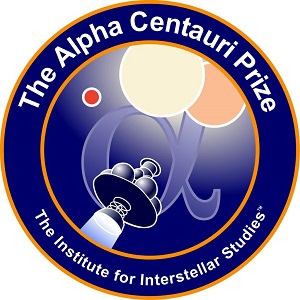
The Dallas gathering that convenes this Thursday will be the third major interstellar conference so far this year, following conclaves in Huntsville (Tennessee Valley Interstellar Workshop), San Diego (Starship Century) and preceding September’s 100 Year Starship Symposium. In addition, a conference on The Philosophy of the Starship was held by I4IS in London in May. In that suddenly quickened climate for interstellar studies the judges for the Alpha Centauri Prize Progenitor Award are being asked to make their selections based on originality, direct relevance to interstellar flight, and the potential of the work to be viable both technologically and economically in this century.
Addendum: Kelvin Long writes to tell me that another Starship Century conference will take place in London this October, along with a conference on Project Icarus. More on these when I have further information.
The Progenitor Award is the first of what is to become a series of awards in deep space design. Subsequent awards are, according to an email from I4IS executive director Kelvin Long, to be launched over the next two years. The intent is to provide incentives for design work of relevance to interstellar flight. A recent post on the Institute for Interstellar Studies website offers this:
We will set technical standards for physicists, engineers, biologists and scientists to reach for, harnessing the skills of old, and building the skills of new. We will foster and encourage pathways to new design concepts which solve old problems, and generate insights into new ones…
As explained in the I4IS post, the larger motivation is to adopt the lessons learned in the Ansari X-Prize competition to spur innovation and create technical developments in interstellar research. Here the future competitions become ambitious indeed, encompassing design studies by international teams of 6-10 designers, with each team submitting a final report to a judging panel after a development time of one year, and recurrent competitions taking place every two to three years. The plan is to drive design work in a host of projected technologies:
The Alpha Centauri Prize would be an international competition that has the function of incentivizing research, contributing technical knowledge, developing designer capability whilst inspiring the public towards the vision of interstellar flight. It is one of the best ways to advance the prospects for interstellar travel, and to have separate design studies, which could be derived, iterated and improved. Over time, the concept would be worked upon by future generations and ultimately lead to a direct design blue print for an interstellar probe after several decades of running. Like the BIS/Icarus Interstellar Project Icarus and the soon to be announced I4IS Project Dragonfly, it is the hope that other teams around the world would be assembled to work on specific proposals investigated historically such as NERVA, Starwisp, Vista, Longshot, AIMStar, Orion or one of the many others.
Long and Icarus Interstellar’s Richard Obousy created Project Icarus in 2009 as both a continuation and redefinition of the 1970s era Project Daedalus. The competition foreseen in the Alpha Centauri Prize, unlike Icarus, does not focus on a single propulsion system but considers all options from solar sails to antimatter, eschewing redesigns of historical work to create what the site describes as ‘new and innovative design concepts.’ I4IS envisions competitions taking place every two to three years to increase the technological readiness of different propulsion schemes, with eventual cash prizes in the $10,000 to $100,000 range:
After running the competition for two decades we may find that what may emerge is not a single choice for going to the stars in the coming centuries, but instead a realization that it is a combination of approaches with highly optimized engineering designs that will be the way to go. This may suggest hybrid propulsion schemes and could for example be along the lines of a fusion-based drive with anti-proton catalyzed reactions but using a nuclear electric engine for supplementary power and perhaps a solar sail and MagSail for solar system escape or upon arrival. From the two decades of research will develop reliable engineering studies, practical progress of the technology and several clear front runner designs to focus initially divergent research options towards the proper investment into the clear front runner designs by a process of gradual down select.
Competitions have proven their worth in aviation and aerospace (think Lindbergh and Burt Rutan), but in those cases we were dealing with existing or near-term technology and building hardware. What I4IS intends with the Alpha Centauri Prize is to turn the same principles to work at design studies that will surely out-run present-day engineering. It’s an idea that worked with the volunteer teams that have designed Daedalus and are now designing Project Icarus. With government funding all but non-existent on most of these concepts, it’s heartening to think that philanthropic alternatives can be found to push studies across the spectrum of propulsion options. A torrent of research papers would be a welcome outcome of such competitions.


